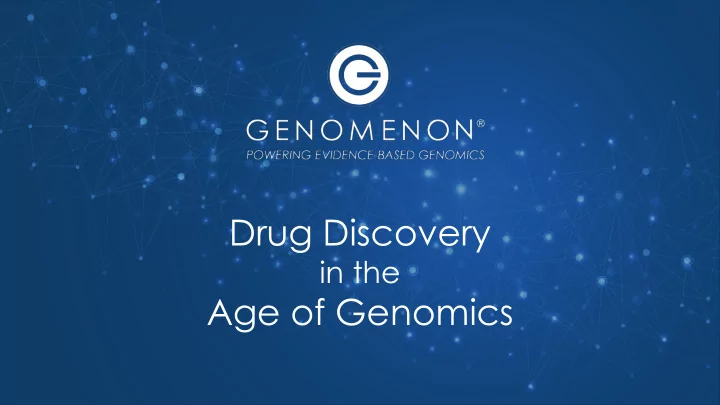

Drug Discovery in the Age of Genomics
Mark Kiel, MD PhD Alex Joyner, PhD Senior Field Application Scientist, Genomenon Founder and Chief Science Officer, Genomenon Biomedical Sciences & Bioinformatics Molecular Genetic Pathology University of California, San Diego University of Michigan, Ann Arbor www.genomenon.com | hello@genomenon.com | @genomenon
Outline DRUG DISCOVERY IN THE AGE OF GENOMICS 1. WHY use Genomics? • Core Benefits and Applications of Genomics 2. HOW should we go about it? • Practical Considerations for Use of Genomic Data 3. WHAT are some Examples? • Representative Case Studies 3
Core Benefits and Applications of Genomics 4
“[G]enetically supported targets could double the success rate in clinical development” 5 Nat Genet. 2015 Aug;47(8):856-60.
GENOMICS EMPOWERS PHARMA TO: • Optimize Pre-Clinical Therapeutic Targets • Reduce R&D Costs • Maximize Success of Clinical Trials • Expedite FDA Approval • Decrease Time To Market 6
OPTIMIZE PRE-CLINICAL TARGETS • Understand the biomolecular basis of disease • Identify new pathways in complex disease • Provide a molecular starting point for targeted therapy • Discover biomarkers in disease populations • Disease-Causing • Response-Modifying • Response-Monitoring 7
1950 - 1970 Phenotypic Screening 1970 - 1990 Putative Protein Target 1990 - 2003 EST Studies 2003 - 2013 GWAS Studies 2013 - now NGS Studies 8 Nat Rev Drug Discovery 2018 March; 17(3):183-196
REDUCE R&D COSTS • Focus on High-Yield Candidates • Decrease Failure Rate • Save on Opportunity Costs 9
“The cost to develop new therapeutics has increased significantly over the past 30-40 years, while the success rate has remained unchanged .” “Many therapeutic failures occur after large investment.” J Transl Med . 2016; 14:105. 10
MAXIMIZE SUCCESS OF CLINICAL TRIALS • Use Genomic Markers as Inclusion/Exclusion Criteria • Ensure a More Homogenous Patient Cohort • Establish a Molecular Companion Diagnostic • Increase Drug Response Rate • Add Statistical Power to the Study 11
https://www.q2labsolutions.com/companion-diagnostics 12
EXPEDITE FDA APPROVAL • Provide Supporting Data for Biomarker Candidacy • Establish Objectivity with Genetic Evidence • Support Understanding of Pharmacogenomics • Proactively Strengthen Initial Submission 13
The future of the drug approval process Linda Honaker; figure Rebecca Clements. 14
DECREASE TIME TO MARKET • More Efficient Product Development • More Innovative Clinical Trial Design • e.g. n-of-1 trials • Out-Compete Competitors 15
Practical Considerations for Use of Genomic Data 16
SELECTING THE RIGHT OMIC DATA 1. Single Nucleotide Variants and Indels 2. Structural Alterations – Copy Number Variants 3. Structural Alterations – Fusion Genes 4. Transcriptome – Gene Expression 5. Epigenetic Change – Methylation Marks
A GENETIC WORKFLOW MODEL 1. Determine Study Parameters 2. Design Cohort Composition and Inclusion Criteria 3. Perform Sequencing/Array Experiment 4. Analyze NGS Data
PRIMARY & SECONDARY ANALYSIS DNA to Data chr ATGC Gene FASTQ BAM VCF
TERTIARY ANALYSIS Variant Interpretation - The Evidence Triad (ACMG/AMP) PUBLISHED LITERATURE PREDICTIVE POPULATION MODELS DATA
TERTIARY ANALYSIS External Curated Data Sources
QUATERNARY ANALYSIS Cohort Analysis - Putting it all together at the population level AGGREGATE ANNOTATE ASSESS
COHORT ANALYSIS • Phenotypic and genotypic homogeneity is beneficial • Presence/absence of a disease-causing mutation as inclusion/exclusion criteria in a clinical trial • Population-level sequencing identifies large, homogeneous cohorts for specific diseases for clinical trials • UK Biobank, Finngen, deCode, Genomics Medicine Ireland
Representative Example Studies 24
GAIN OF FUNCTION: V600E BRAF mutations in Hairy Cell Leukemia Tiacci et al. NEJM 2011 Jun 16; 364:2305-15. 25
GAIN OF FUNCTION: NOTCH2 Kiel et al.J Exp Med 2012 Aug 27;209(9):1553-65. 26
GAIN OF FUNCTION: JAK-STAT 27 Kiel et al. Blood. 2014 Aug 28;124(9):1460-72.
LOSS OF FUNCTION: SEZARY SYNDROME Kiel et al. Nat Comm 2015 Sep 29;6:8470. 28
THE PROMISE OF GENOMICS IN DRUG DISCOVERY Complex and heterogeneous diseases – examples of strongly activating mutations Conditions with genetic heterogeneity – pathway homogeneity uncovered by genomics Across multiple related disease types – convergence of treatment strategies 29 Nat Rev Drug Discovery 2018 March; 17(3):183-196
MASTERMIND GENOMIC DATABASE A Comprehensive Index of the Genomic Literature, Annotated for Clinical and Functional Variants 30M 6.7M TITLES/ABSTRACTS FULL-TEXT GENOMIC SCANNED ARTICLES INDEXED 10K DISEASES 25K GENES 4.9M VARIANTS 30
Thank You hello@genomenon.com | www.genomenon.com |1-734-794-3075 31
Sign Up for Mastermind Basic Edition and get 14 days of Mastermind Pro bit.ly/mm-pharma
Recommend
More recommend